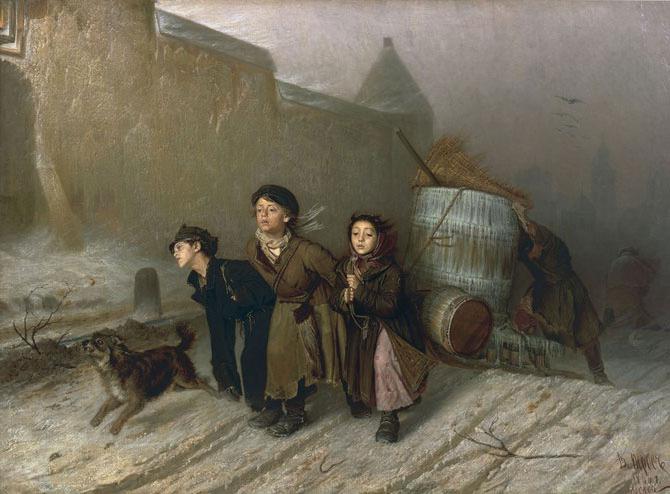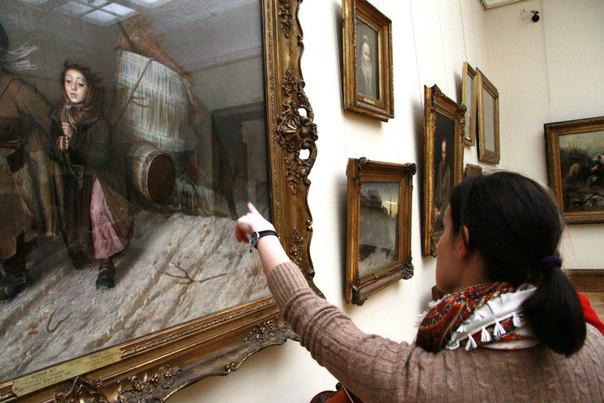The painting "Three" is one of the most significant works of the artist V.G. Perova. It depicts the children of the poor, carrying a barrel of water along an icy road. Many years have passed since its writing. Both the contemporaries of the picture, and today's spectators, the master’s work causes tears in their eyes and a high sense of compassion for people. The author of the painting “Three”, using
artistic means, tried to recreate the atmosphere of gloomy doom that reigned in the world of the poor and destitute. Currently, this work of art is in the Tretyakov Gallery in Moscow.
A few words about the author of the canvas
The painting "Three" is perhaps one of the most emotional and famous works of the artist Vasily Grigoryevich Perov. He was born in the city of Tobolsk. When his parents moved to the Nizhny Novgorod province, the future great master enrolled in Arzamas district school. There, he studied intermittently at an art school, which Vasily never managed to finish. But later, the future artist was educated at the Moscow School of Painting, Sculpture and Architecture. During his life, the master painted many wonderful paintings. Among them are such works as “Arrival of the Stanovoy”, “Workman Boy”, “Crying Yaroslavna” and many others.
Painting "Three": description
This work was written by the author in 1866. It was a difficult time for Russia. Serfdom was already abolished, but this did not correct the plight of the Russian peasantry. His life was still poor and destitute. Many masters of art were then worried about the topic of social inequality, the lack of rights and the poor peasants, the compulsion to pay with a “teardrop of a child” for some life benefits.

This is reflected in his picture by the artist. In the center of it are three children (artisans' students) carrying a huge icy barrel of water. These are two boys and a girl. In the yard winter is getting dark, on the road there is ice. A sharp cold wind inflates their inferior clothes. Water pouring out of the barrel immediately turns into icicles. How cold the children must be in such a cold! .. It is evident that they are completely exhausted. Some kind person helps them to drag the barrel to the hill. The cart is accompanied by a dog that runs a little to the right in front of the children. The picture is painted in dark gray-brown tones. Even the snow around is dark. Thus, the master wanted to show the viewer all the dullness, hopelessness and horror of the situation when young children are forced to do such a dirty job. An icy deserted street also pumps the atmosphere. What are the characters associated with the picture of the audience? Its name itself suggests that the work of these children can be compared with the work of horses. The public, the work in question causes acute pity for the poor children, who suffered such a difficult fate.
main idea

The author of the picture "Three" here addresses the topic of child labor in Russia in those years. Now it’s difficult for us to imagine a situation where it was completely legal and absolutely normal, from the point of view of the then existing system, a phenomenon. How much bitterness and pain in the title of the work! We are more accustomed to calling triples a group of frisky horses racing at high speed across the vast boundless expanses of Russia. And then the poor and exhausted children, forced to pull an excessive burden on a frosty day. Many city artisans then burdened their students with such hard work. Children in such hellish conditions were often sick and dying. Looking at the picture, you can vividly imagine the whole hopelessness of the situation. This is exactly what the artist wanted to draw the attention of society to. The work will not leave anyone indifferent, will make you be kinder to people and will not allow you to pass by and not see beside you deprivation and poverty.
Sitters
The author of the work for a long time looked for sitters for his work. For the figures of the girl and the far left boy, he found them. But for the image of the central hero, the artist could not "look after" a suitable child. The painting "Three" was already written more than half when Perov once met a peasant woman on the street with her son, who were walking from a Ryazan village to a monastery. When he saw the boy, he immediately realized that this was the central figure that he lacks on the canvas. Having talked with the woman, the master found out that her name was Aunt Marya, and her son - Vasya. Her fate is not easy. She buried all her children and her husband, who died from illness and want. Twelve-year-old Vasya is her only hope and comfort. After listening to a bitter story, Perov suggested that the woman draw her son. She agreed. So a new character appeared in the picture.
The fate of the protagonist
This story has a continuation. Once, four years after painting, an old woman in a fur coat and dirty bast shoes came to Perov. In it, the master hardly recognized the very aunt Mary. She handed him a small bundle of testicles. “As a gift,” the woman explained. With tears in her eyes, the peasant woman told the artist that her Vasya died last year, was seriously ill. Left completely alone, the woman sold all her belongings, worked all winter, and, having accumulated a little money, she came to Perov to redeem a picture of her beloved son on her simple savings. The master explained to the poor mother that the picture "Three" is in the gallery, that it is impossible to acquire it. But you can see her. When the woman faced the painting, she fell to her knees and, wept bitterly, began to pray at her. Touched by this scene, the artist promised his mother to paint a portrait of her son. He fulfilled his obligation and sent his work in a gilded frame to the woman in the village.

This article describes Perov’s “Troika”, as well as talks about the author and the facts associated with its creation. We hope that the information will be interesting to a wide circle of readers.